
 | |
| Volume 8, Number 3 | May/June 2002 |
Is it possible for a son to die of old age while his father is yet in mid-life? Genesis says yes—and reveals important properties of vitamin X in doing so.
The Biblical life expectancy data (right half of Figure 1) display a more-or-less uniform, natural decline from Noah to Moses. The only real irregularity in this uniform decline, allowing for normal scatter in the datapoints, is a sudden drop in life expectancies between Eber and Peleg (third and fourth life expectancy data points after the Flood). I have highlighted this irregularity by darkening the line connecting the Eber and Peleg datapoints.
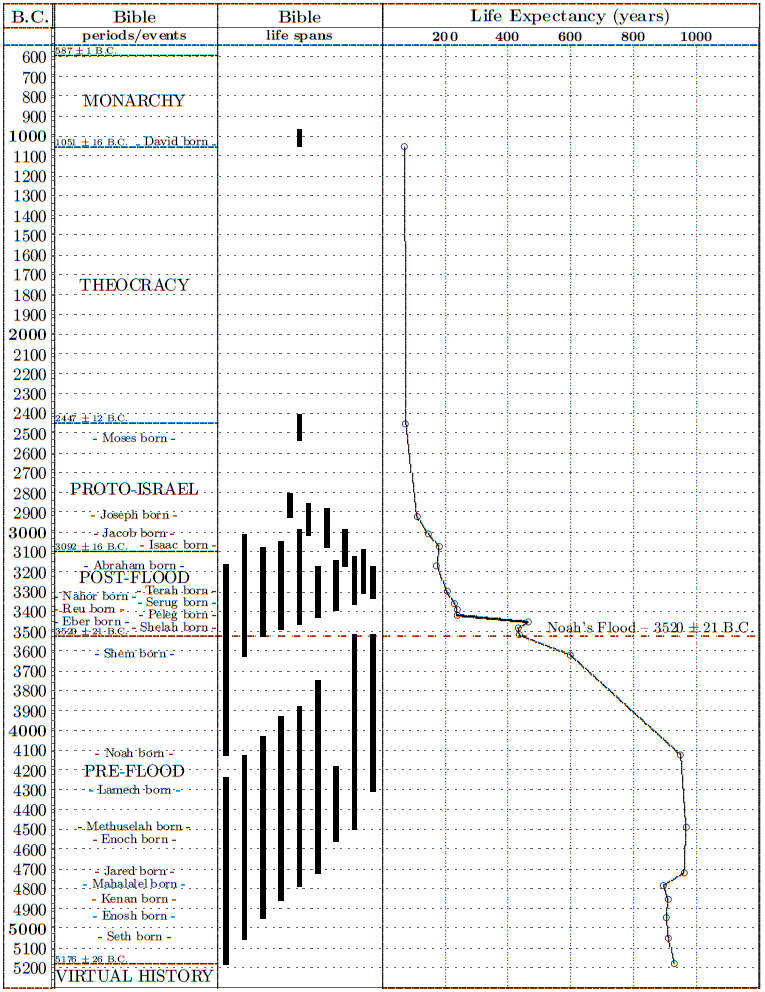 |
This sudden drop in life spans between Eber and Peleg has been used by some to argue for gaps in the Genesis 5 and 11 genealogies from which much of these life span data have been taken (Table 1). The argument in this case is that it is unlikely that life spans would have changed so dramatically in a single generation—from 464 years for Eber to just 239 years for Peleg. If one makes the reasonable assumption—so the argument goes—that life spans continued a natural decline between Eber and Peleg, then clearly there must be a number of generations missing between Eber and Peleg.
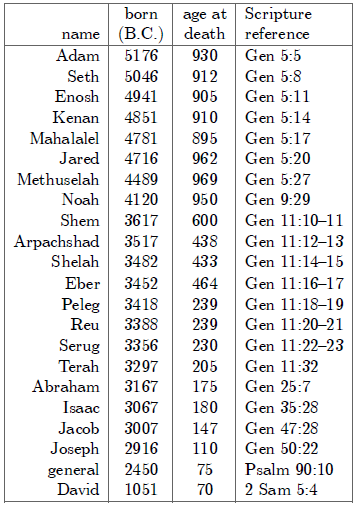 |
In point of fact there are no generations missing between Eber and Peleg. The sudden drop in life spans between Eber and Peleg is real history. That is, it really was the case that Peleg was Eber's direct, first-generation son, and that Peleg died of 'old age' nearly two centuries before his father died of 'old age', while his father was yet in mid-life.
I think I will have proven this assertion to everyone's satisfaction before too many more articles in this series have gone to press. For the present, however, my purpose is more modest. I want, this issue, to show only how such a thing is possible. And even this is secondary to the much more urgent goal of elucidating the properties of vitamin X—the anti-aging vitamin—in hopes of identifying what substance this elusive vitamin is. I aspire, this issue, to take a first small step toward this goal by demonstrating two properties of vitamin X: first, that it must have a relatively long biological half-life, and second, that it must have a relatively short environmental half-life. These properties both follow logically from the sudden drop in life spans which the Bible records between Eber and Peleg.
What is biological half-life?
Biological half-life is a measure of how long a substance tends to remain in the body before it is eliminated.
The biological half-life, T, of a substance in the human body can be measured by giving a person a small dose, N0 molecules, of that substance and measuring the number of molecules, N, of that dose remaining in the body after an elapsed time, t. The biological half-life is the time it takes for one half of the original dose molecules to be eliminated from the body; that is, the time it takes for N to equal N0/2.
Sodium, which we get from common table salt, sodium chloride, is used in tissues throughout the body. It has a relatively short biological half-life of just 29 days.[1] Calcium, on the other hand, tends to get tied up in bone, and has a relatively long biological half-life of 49 years.[2]
I have previously argued that 'old age' is simply a poor name for what in reality is a vitamin deficiency disease.[3] I have dubbed the unknown substance which is responsible for preventing 'aging' "vitamin X".[4]
Imagine two modern individuals, Bob and Tom, of the same age—say twenty years. If neither is given supplemental doses of vitamin X, then both will die of vitamin X deficiency disease ('old age') within a few decades of seventy-five years. We know this with fair certainty because billions of individuals have proven it since the Flood.
Now imagine that Bob is given supplemental doses of synthetic vitamin X so that he gets all the vitamin X his body needs from age twenty on, while Tom remains at a natural, present-day (deficient) level of vitamin X. Tom will still contract 'old age' and die of it within a few decades of 75 years. But not so Bob. Bob will not contract 'old age' at all, any more than a person receiving an adequate diet of vitamin C will contract scurvy.
We see by this simple example that two individuals of the same age, living at the same time, can experience very different rates of 'aging' depending on their respective dose rates of vitamin X.
Now imagine that Bob is given synthetic vitamin X for one year only, after which he, like Tom, receives only a natural present-day level of vitamin X. What will be the result?
If vitamin X has a biological half-life measured in days, like sodium, then the benefit to Bob of his year-long supplemental dose of vitamin X will be merely to increase his life expectancy by one or two years. But if vitamin X has a relatively long biological half-life, say 49 years, like calcium, then Bob would be expected to outlive Tom by a century or more. The reason for this is that, in the case of a long biological half-life, vitamin X continues to be maintained at high levels in Bob's body long after supplemental dosing has stopped.
This is what happened in the case of Eber and Peleg. Since no means of artificially synthesizing vitamin X was available, Eber and Peleg were limited to only that dose of vitamin X which the environment naturally provided. Eber was born at a time when the amount of vitamin X in the environment was much higher than it is today. Sometime during the thirty-four years between the birth of Eber and the birth of Eber's son, Peleg, the amount of vitamin X in the environment declined dramatically. There is a very good reason why the amount of vitamin X in the environment declined this way, which I plan to explain in detail in a future article in this series. For now I want us merely to notice that, as a result of this decline, the natural dose of vitamin X received by Peleg was always much less than that which his father Eber had initially received.
From Peleg's birth on, both Eber and Peleg were receiving the same, relatively low, natural dose of vitamin X from the environment. But even though they were both limited to the same natural dose-rate of vitamin X from Peleg's birth on, Eber did not die of 'old age' at the same time Peleg did. Eber lived on for several centuries after Peleg, his son, had died of 'old age'.
Eber outlived his son Peleg by several centuries because Eber carried a higher level of vitamin X with him, in his body, long after vitamin X had declined dramatically in the natural environment.[5] This shows that the biological half-life of vitamin X must be relatively long—probably on the order of a century.
The long biological half-life of vitamin X is apparent in the Genesis life span data in many other instances than just Eber and Peleg. Notice, as a single additional example, that Shem, who accompanied his father Noah on the ark, outlived not only Peleg, his great-great-grandson, but even Terah, Peleg's great-great-grandson (and father of Abraham). Said another way, Shem, born before the Flood, died of 'old age' only 25 years before Abraham—born 350 years after the Flood—died of 'old age'.
Clearly, vitamin X has a long biological half-life.
In contrast to its biological half-life, vitamin X must have a relatively short environmental half-life. This is apparent from the rapidity of the drop in life expectancy between Eber and Peleg. This drop in life expectancy requires that the environmental abundance of vitamin X dropped dramatically between Eber's birth and Peleg's birth. The time between these two births was just 34 years.[6] Thus we learn that vitamin X in the natural environment can decline dramatically in a matter of a few decades or less. This is just another way of saying that vitamin X has a relatively short environmental half-life—on the order of a decade or less.
Is it possible for a son to die of old age while his father is still in mid-life? Genesis says yes—and there is really no sound reason to doubt it. ◇
Though Ai, the second city of the Conquest, was excavated over sixty years ago, the average Christian, in America at least, knows nothing of the mass of factual information unearthed by the archaeologists at Ai. A large part of the reason for this widespread ignorance lies in the fact that the original excavator found no city existed at Ai at the traditional date of the Conquest. This problem caused a great deal of confusion in scholarly circles initially, which, with mounting evidence of similar problems everywhere in Palestine over the ensuing decades, slowly transformed into skepticism, and then outright rejection of the Biblical account of the Exodus and Conquest—as is the unhappy (and unnecessary) case at present.
A smaller part of the widespread ignorance regarding the factual data from Ai lies, I am convinced, in the simple fact that the excavation reports from the first major work at Ai were published in French. The shame here is that these original reports go a long way toward showing that both the archaeology and topographical situation of Ai match, in detail, with what one might naturally expect from the Biblical account of the Conquest of Ai. They thus show that the only real issue at Ai is the chronology of the site relative to the traditional Biblical chronology date of the Conquest.
I have previously shown that it is traditional Biblical chronology which has the problem—it has accidentally overlooked a full thousand years because of a minor copy error in 1 Kings 6:1.[7] Once this has been understood, all apparent difficulty between the archaeology at Ai and the Biblical narrative of the Conquest of that ancient city disappears.
The only remaining impediment to full appreciation of the archaeological finds at Ai, then, is the language barrier posed to much of the English-speaking world by the French of the early excavation reports.
My ability with foreign languages is extremely limited—despite the best efforts of some fine high school teachers several decades ago. Fortunately, however, my eldest son, Mark, demonstrates considerable aptitude with languages. He undertook to translate the excavation reports from Ai some months ago. I have invited him into class again this issue to begin to share with us—for no other reason than a general broadening of our knowledge—some of what he learned in this exercise. Once again, here's Mark.
I set out to translate Les Fouilles De 'Ay, (The Excavations of Ai[8]), the published report of the first major excavations at Ai, because I knew that Ai was an important archaeological site to modern Biblical chronology, and I wanted to make sure we hadn't missed anything important in our previous skimmings of the French text. I found no new grand facts or solutions to any major mysteries, but I found a story there that I believe is worth retelling. It's a story about people—men, women, and children who lived at Ai and died at the hands of Joshua's soldiers—and the story of a young woman whose greatest passion was to discover the long-forgotten truth about those people.
It is necessary to note that I am not a professional translator, nor even a fluent speaker, of French. I am doubtless to blame for any oddities or errors in the quotations below. Also, in the interest of accurate and precise transmission of the original content my translation tends to be more literal than paraphrastic, preserving the complex sentences and grammatical arrangements of the original. I ask your patience in reading the sections that don't flow as smoothly as they otherwise might. I think your patience will be rewarded, for here is an opportunity to participate in a valuable exercise, nearly extinct in modern society—looking back through the mists of time to learn from the ancient past.
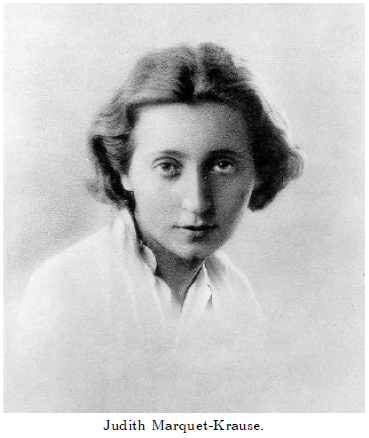 |
The 1st of July, 1936 Mrs. Judith Marquet-Krause was abruptly taken by a sudden and unrelenting illness, at the moment when she was going to undertake the preliminary report of her third campaign of excavations at et-Tell—Ai.She had already organized the resumption of the work at the end of the summer of 1936 and previous success justified all expectations. The valiant explorer had considered an initial synthesis of the results, acquired in three years of labor conducted with a most desperate enthusiasm, to be in the very near future. The new campaign must be above all devoted to carry through the investigation on the essential elements of the archaeological reconstruction of Ai: the complex system of fortifications, the acropolis with its civil, military, and religious monuments, and a notable part of the ancient cemetery. Note cards of all kinds, more or less elaborate notes, inventories, plans, designs and photographs, accumulated over three years with the most ardent activity, clearly represented since that time, in the imagination of the young scholar, an archaeological resurrection of the famous forgotten city, of which some early records had only outlined the essential traits and sketched the development.
Destiny, the implacable guardian of the secret of Ai—the "Ruin"—has venged itself of her more courageous adversary, who took with her the vision of her victorious discovery.[9] % Documents and collections, which, looking empty, frozen by the cold of death, though ancient still, live and are organized under the wand of a fairy, and the treasure of materials, though laboriously recovered—changed from useless rubbish, has added her mournful silence to that of the ruins of Ai.
Judith Marquet-Krause was the wife of Yves Marquet, the writer of the foregoing poetic words. As a young woman in her twenties she was responsible for the first archaeological investigation (other than some preliminary soundings by Garstang) of the ancient ruins of the city of Ai. After her untimely death, her mother wrote:
I am interested in nothing more than the sole desire to see continued the dear memory of the child prematurely taken by her disease; her miserable mother must strive to express the sorrowful memories that set down for the reader the traits of Judith Krause-Marquet.Born at Sedjera in 1906, in that enchanted part of Galilee from where one can see the mountains of Nazareth on one side and Mt. Tabor on the other, there she spent her earliest years. There she received her first moral and intellectual education and, in the house of her father, was instilled with a sense of honor and the love of work. From her tender infancy, a noble and generously inspired person.
She received her brilliant secondary schooling at the Tel-Aviv high school, where, in addition to Hebrew, the assigned language, she delved deeply into French, her mother language, and learned Arabic, English, and German. At the age of seventeen she returned to France to do her higher studies. Successively graduating from the Sorbonne, from the School of Higher Learning and finally from the School of Louvre, she acquired a degree in inscriptions, studying Syriac close at hand to the sympathy of Abbe Nau, then cuneiform, then archaeology. It is Mr. Rene Dussaud, now Perpetual Secretary of the Academy of Inscriptions and Scripts, who directed her studies and her first steps in her archaeological career.
After having worked a semester at the excavation of Jericho at the hand of Professor Garstang, she was charged with the mission by the sympathy of Baron Edmond of Rothschild and directed the three campaigns of excavations at Ai, of which the present volume reports her findings. …
In order to delve deeply into the literary and archaeological sciences, she loved to travel, mostly in Europe and the East. Consequently, along with the museums of Beyrouth, Constantinople, Alexandria, and Cairo, she visited a number of museums of eastern archaeology in Italy, Germany, Austria, and England. She likewise visited many archaeological work sites in Palestine and Syria. Her doctoral thesis was on work sites. God gifted her with a high superiority, of an exceptional nature whose mystery was full of promise. He had focused her thoughts toward a single ideal, scientific research. In spite of her great love for her parents, and for her husband, her work had the first priority. Nothing was more important to her than biblical history work, and she devoted herself to it with enthusiasm. It is more than certain that she had an intimate contact with her soil, she saw treasures there. The success of her work is remarkable. The importance of her discoveries is an army which can defend itself. She expected to work some years more at Ai, but she had already turned her sights toward the Tell of Hatsor, near Yessod Hamaalah, where she was convinced important historical remains lay hidden. The savage region, the malaria which reigns there, could not stop her determined idea.
When I saw the work in the caves, in the unbreathable air, I was then aware of the terrible dangers. Surrounded by the heavy gloom in which I had let go of the loss of my only son, I left in spite of being carried away on this slope which plunged me there still more deeply. Alas! at that very hour, my beloved Judith, that charming and noble soul, found herself at the hand of the Creator where she awaits our eternal reunion.[10]
Judith called Ai a "major biblical city" because of its prominent role in the biblical story of Joshua's conquest of Canaan. She excavated at Ai in the 1930's, a time when questions about the historicity of the biblical account of the Conquest were beginning to surface in the archaeological community. She wanted to find objective evidence and apply it to the issue. What she found almost didn't make it into print:
The present work would have appeared at the beginning of 1940—the last test was the editing of the books, at the eve of the declaration of war. But fate, unleashed on the whole world, fell upon the passing of the explorer. Having survived the catastrophe of May-June 1940, the proofs disappeared. Meanwhile the inhumanity of the occupants was exercised against the residents, the administration made them melt down the printer's type for transformation into ammunition.By chance, a first proof, along with all the photographic plates, was saved.
This book goes therefore, at last, to see daylight, specifically due to the overthrow of the Nazis.[11]
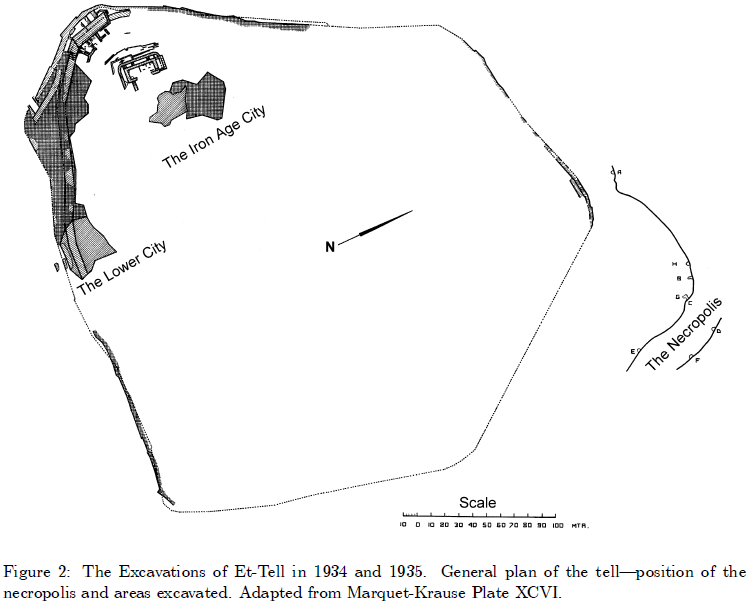 |
Judith began her report on the first season of excavations this way:
With September 1933, the well-organized mission, at the generosity of Baron Edmond of Rothschild, to excavate the mound of Et-Tell, the presumed site of ancient Ai, found us at the outset of the work.[At this point Judith thanks eight individuals who aided her excavation project. Among them are her mother, who helped to manage the project, and her father who handled the "delicate negotiations" necessary to arrange permission from the Arabs to work at the site. Her gracious (and lengthy) acknowledgments show an unselfish perception of the valuable contribution each person made.]
The work on the area was inaugurated on the 13th of September with about fifty workers recruited exclusively from the Arab village of Deir Diwan. None of them had ever had practice at this very particular kind of labor; but constant and firm direction did not take long to produce results. Half a dozen more intelligent and more flexible men, chosen with care, soon made a very useful special crew: an advantageous resource for the training of groups and the accomplishment of more difficult tasks.[12]
Conscious of the importance of positively identifying the correct site of ancient Ai, Judith Marquet Krause included the following remarks in one of her reports:
The location of the ancient city of Ai is clearly determined by the Old Testament. It is found on a hill to the east of Beitin, ancient Bethel, 25 kilometers north of Jerusalem.Joshua 78:2: "Joshua sends some men towards Ai, to the east of Bethel..."
Genesis 12:8: "He (Abraham) moves towards the mountains to the east of Bethel and he pitched his tent with Bethel to the west and Ai to the east."
The Tell, of nearly circular shape (plate LXXXIX) covers an area of 10 hectares [24.7 acres].
The spring is found at the west, outside of the city. Looking north, a natural system of defense is apparent, made up of a series of superimposed terraces. On the southern side, the slope is shallow. To the north and the west, the Tell is surrounded by a chain of hills which is separated by a deep ravine. Bethel, to the west, is invisible, in spite of the short distance. On the east side, the view reaches the Jordan Valley and the area north of the Dead Sea. One sees, to the north, the Arab villages of Tayibe (ancient Ophra) and of Ramoun (ancient Rimmon). All of this is in perfect harmony with the Biblical data.[13]
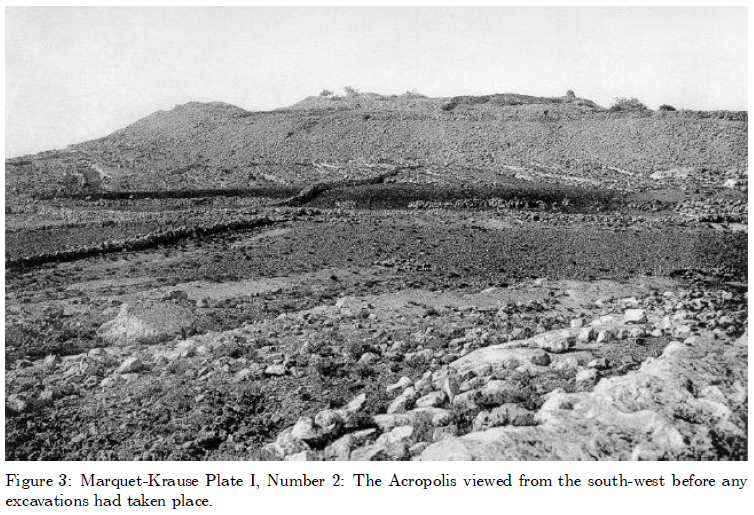 |
Judith's excitement is evident in her description of the first discoveries:
Our first effort naturally had to concentrate on the Acropolis, at the point culminating north-west of the Tell, the mound par excellence. No ancient remnant protruded, to tell the truth, from the pieces of rubble in which withered a couple of shriveled trees and some vine stumps. But from my first prospecting visits the preceding year, the situation from the terrace indicated privilege. Also, the strange combination of very ancient shards and Israelite shards from at least a millennium later convinced me that such a site must certainly not always have been the melancholy desert that it is at present. The pickaxe was soon made to confirm that deduction, and made some masonry complexes apparent, some of which were quite important.
The need for control and for registration [i.e., cataloging each piece of pottery, etc.] suggested at once the duplication of the work site. While a choice crew continued to uncover these buildings, the bulk of the work force, which was growing from somewhere day by day, was employed in the uncovering of the ramparts. Their general outline, probed not long ago from some scarce points, could be followed in an approximate manner on the surface by the movements of the soil or some mass of rubbish in between some tiered terraces. Checking at various depths along the perimeter of almost all of the mound gradually confirmed these superficial indications.
However, a thorough inspection of the lower slopes of the mound caused me to suspect the placement of the ancient necropolis [i.e., cemetery], I immediately employed a small section of my better workers on some soundings where I was visibly pleased by their ability for clandestine excavations. In a few days I had therefore marked out some underground tombs. The site was staked out under constant surveillance, and there was not the slightest surprise for our men at seeing that after hastily clearing out these tombs, we retained only one or the other of the men for stepping into them, those more dexterous and careful, to support us in a meticulous excavation, achieved, for the most part, with our own hands.[14]
All the crews competed for the activity of journalizing the alluring, and for the most part unexpected, finds. Therefore the mission prospered as well as one could wish, for six weeks, when suddenly exploded, toward the end of October, the most untimely political agitation in the Muslim centers of Palestine. Even though our relations with our workers at all points were excellent, as with all the Arab population in the vicinity, it was wise to suspend the work in order to let the outburst die down and to prevent the event of forceful conflict from compromising, after all, the most perfect clarification of the finds and a first registration of the copious material already accumulated. In the first days of November the continuance of trouble and the approach of the rainy season convinced us to conclude this initial campaign. The results greatly rewarded our efforts; they above all justified the project and calmed my urgency.[15]
To be continued. ◇
The Biblical Chronologist is a bimonthly subscription newsletter about Biblical chronology. It is written and edited by Gerald E. Aardsma, a Ph.D. scientist (nuclear physics) with special background in radioisotopic dating methods such as radiocarbon. The Biblical Chronologist has a threefold purpose: to encourage, enrich, and strengthen the faith of conservative Christians through instruction in Biblical chronology, to foster informed, up-to-date, scholarly research in this vital field within the conservative Christian community, and to communicate current developments and discoveries in Biblical chronology in an easily understood manner. An introductory packet containing three sample issues and a subscription order form is available for $9.95 US regardless of destination address. Send check or money order in US funds and request the "Intro Pack." The Biblical Chronologist (ISSN 1081-762X) is published six times a year by Aardsma Research & Publishing, 412 Mulberry St., Loda, IL 60948-9651. Copyright © 2002 by Aardsma Research & Publishing. Duplication or distribution in whole or in part by any means electronic or otherwise is strictly prohibited without written permission from the publisher.
|
^ Joseph W. Kane and Morton M. Sternheim, Physics, (New York: John Wiley & Sons, 1980), Table 33.1, 577.
^ Joseph W. Kane and Morton M. Sternheim, Physics, (New York: John Wiley & Sons, 1980), Table 33.1, 577.
^ Gerald E. Aardsma, "The Cause of Reduced Post-Flood Life Spans – Part IV," The Biblical Chronologist 8.1 (January/February 2002): 1–8.
^ Gerald E. Aardsma, "The Cause of Reduced Post-Flood Life Spans – Part IV," The Biblical Chronologist 8.1 (January/February 2002): 4.
^ It is not necessary that it be vitamin X itself which is carried forward in time in the body. One or more metabolites of vitamin X will also do. I am ignoring the distinction between vitamin X and its metabolites in an effort to keep the present discussion as simple as possible.
^ Genesis 11:16.
^ Gerald E. Aardsma, A New Approach to the Chronology of Biblical History from Abraham to Samuel, 2nd ed. (Loda IL: Aardsma Research and Publishing, 1993).
^ Note that the word 'Ai' comes from a Hebrew word meaning "ruin" and should be pronounced aw-ee much like the word 'eye' in English.
^ Yves Marquet, "Avant-Propos" in Judith Marquet-Krause Les Fouilles De 'Ay. 1933–1935 (Libarie Orientalist Paul Geuthner, 1949), 1.
^ H. Krause, "La Personalité De L'Exploratrice" in Judith Marquet-Krause Les Fouilles De 'Ay. 1933–1935 (Libarie Orientalist Paul Geuthner, 1949), 6.
^ Yves Marquet, "Avant Propos" in Judith Marquet-Krause Les Fouilles De 'Ay. 1933–1935 (Libarie Orientalist Paul Geuthner, 1949), 2.
^ Judith Marquet-Krause, Les Fouilles De 'Ay. 1933–1935 (Libarie Orientalist Paul Geuthner, 1949), 8.
^ Judith Marquet-Krause, Les Fouilles De 'Ay. 1933–1935 (Libarie Orientalist Paul Geuthner, 1949), 14.
^ Judith Marquet-Krause, Les Fouilles De 'Ay. 1933–1935 (Libarie Orientalist Paul Geuthner, 1949), 8.
^ Judith Marquet-Krause, Les Fouilles De 'Ay. 1933–1935 (Libarie Orientalist Paul Geuthner, 1949), 9.